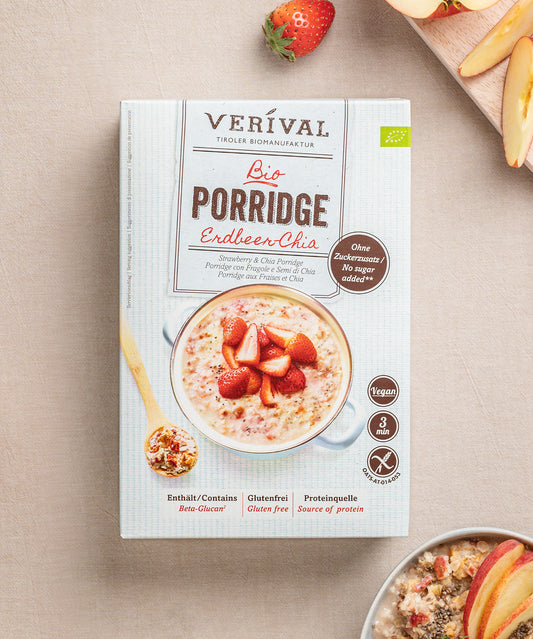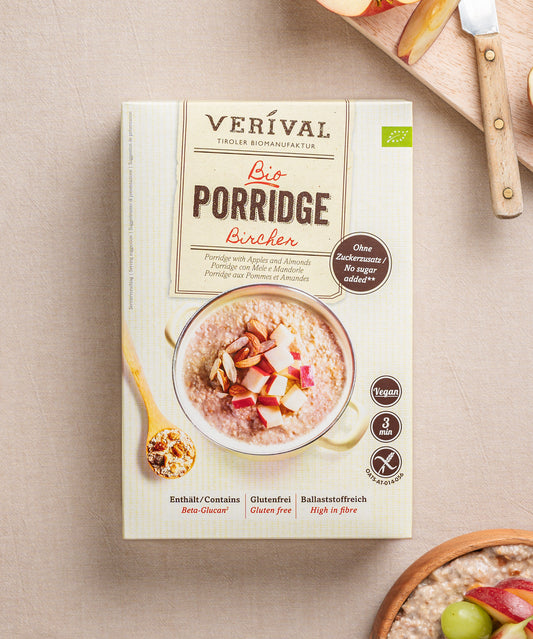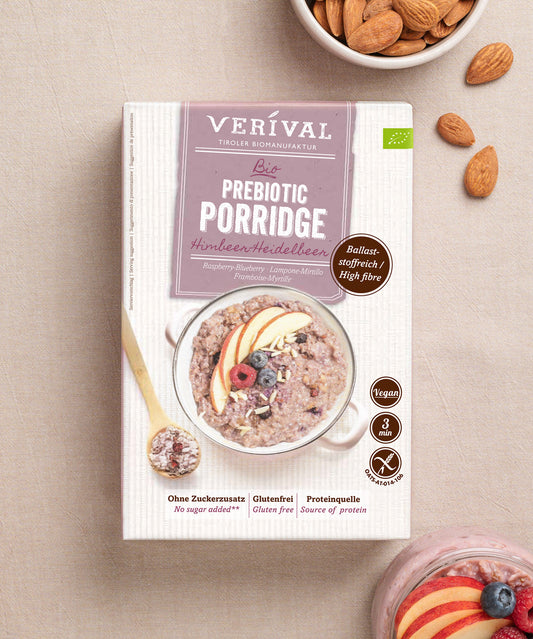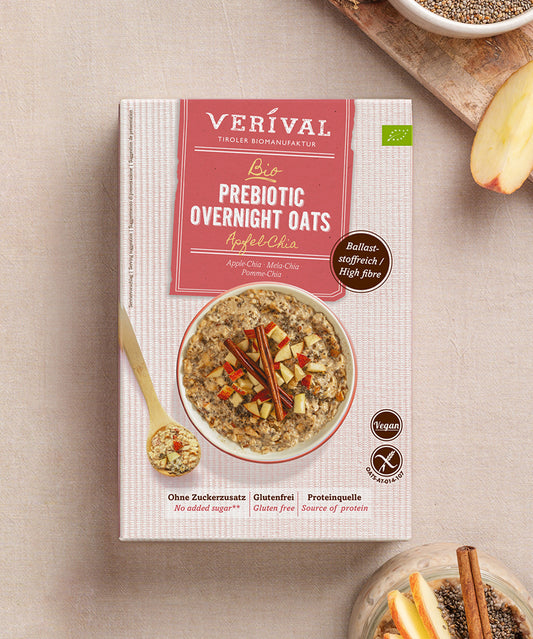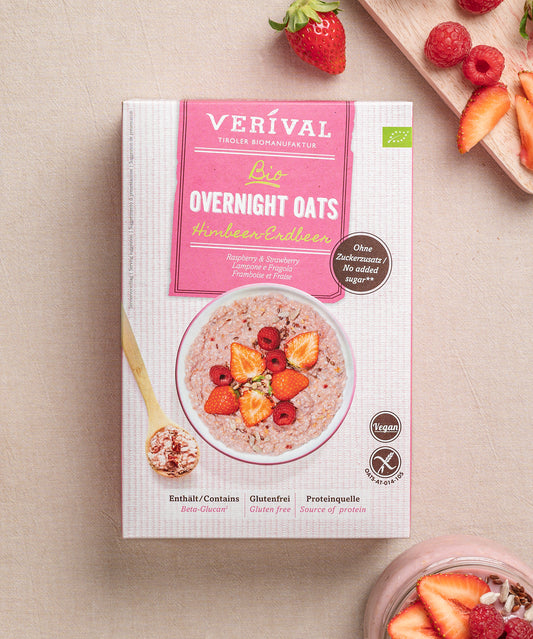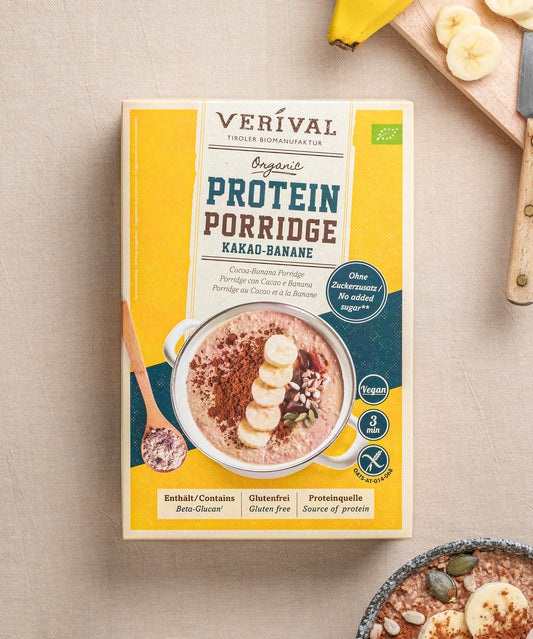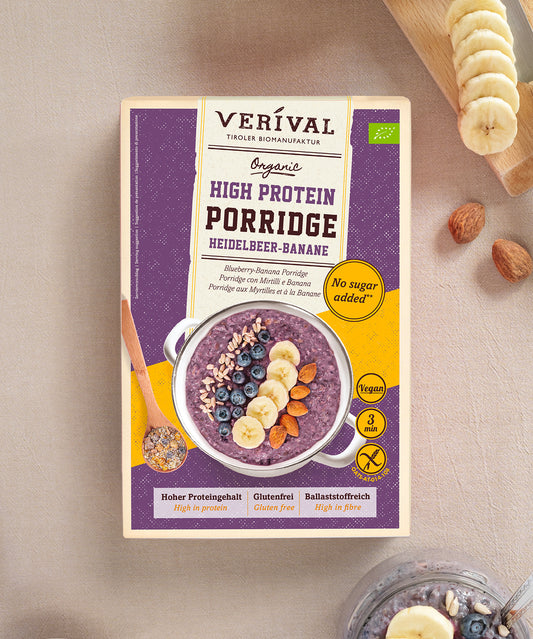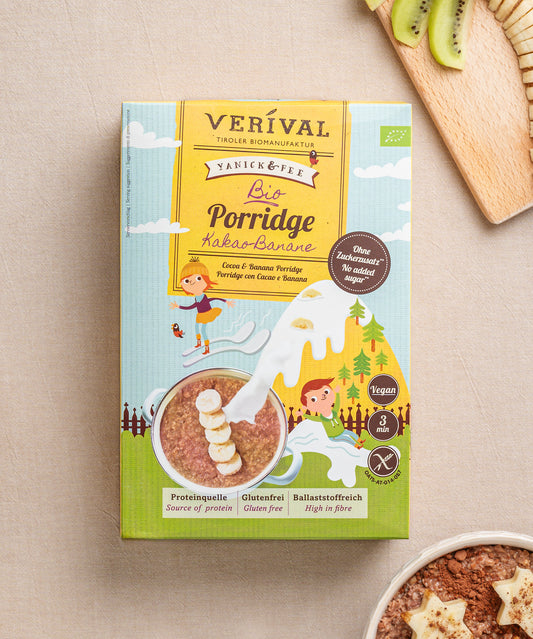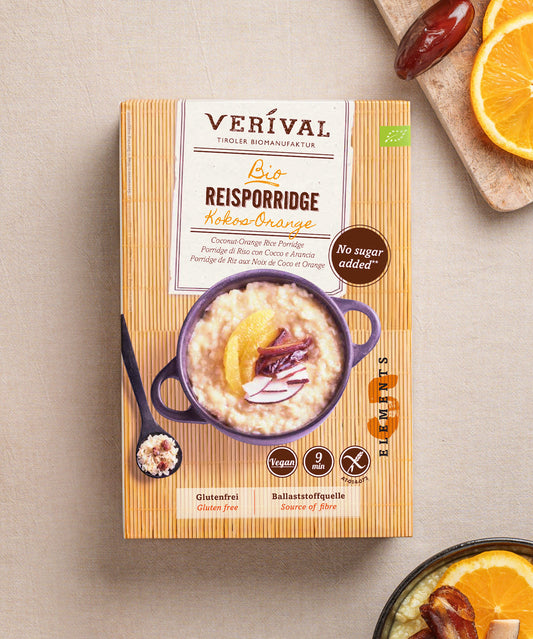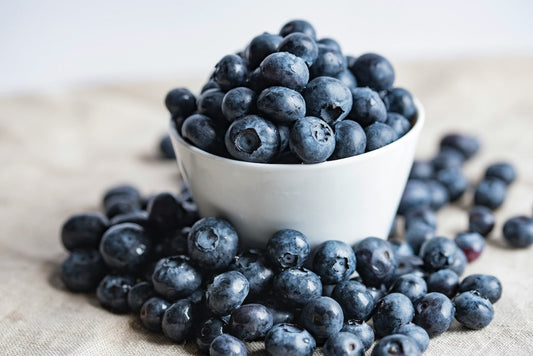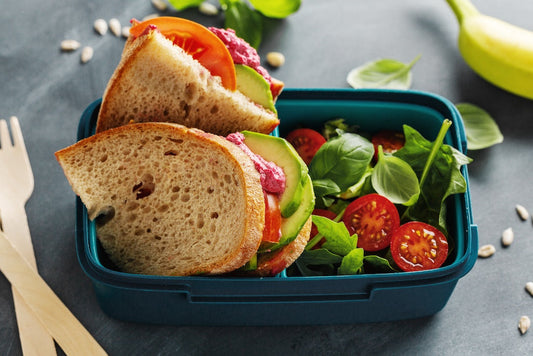Everything you need to know about the ketogenic diet: In recent years, the ketogenic diet has gained importance in science. It is said to have many health benefits. The results of numerous studies are promising, which is why the high-fat, low-carbohydrate diet is even used in medicine. Even if it may sound surprising, the ketogenic diet is also likely to be successful in losing weight. We have taken a closer look at the supposed miracle diet.
VERIVAL Lower Carb breakfast - try it now!
What does ketogenic diet mean?
Those who follow the keto diet get most of their energy from fat rather than carbohydrates. By increasing the fat intake through targeted food choices and largely avoiding the intake of carbohydrates (saccharides), the so-called ketosis is to be achieved. This is a metabolic state in which the body prefers to use fat as an energy source and not saccharides as it usually does. This means that the body switches to fat metabolism.
At first glance, this diet may sound like the widespread low-carb diet (a diet low in carbohydrates). In this diet, 50 to 150 grams of carbohydrates are allowed, which is significantly lower than the standard of an average Western diet.
However, this amount of carbohydrates is too high to achieve the metabolic state of ketosis. Only when the daily intake is less than 50 grams does the body stop producing energy from glucose, i.e. carbohydrates, and switch to producing energy from fat – i.e. burning fat.
All cells of the human organism can meet their energy needs through so-called ketone bodies, which are produced in the liver during this process – including the brain and muscles.
Various studies suggest that the ketogenic diet can help you lose weight, improve the symptoms of various metabolic diseases and diabetes, reduce inflammation in the body and increase brain function. [1]
What does this diet look like?
In order for the body to actually be able to switch energy production from glucose to energy production from fat reserves and to benefit from the discussed health advantages, strict dietary rules apply.
A distinction must be made between therapeutic ketogenic nutrition, which is often used to treat epilepsy or cancer, and the standard version of ketogenic nutrition. In the second form, which is used outside of a medical context, the following composition of the three macronutrients is recommended:
- 5-10% carbohydrates
- 10-20% protein
- 70-80% fat
In the therapeutic variant, the carbohydrate and protein portions are even lower.
The goal of the radical renunciation is that the body switches to fat metabolism. With a balanced diet, the carbohydrates supplied to the body are used as energy suppliers. However, if these are withdrawn, fat reserves are used.
No Gos – Keto Diet
The keto diet involves avoiding all carbohydrate-rich foods. These include, for example, grain products such as bread, pasta, rice or cereals, but also starchy vegetables such as potatoes and corn, as well as fruit and fruit juices. Legumes such as beans or chickpeas also have no place on a ketogenic menu.
Compared to other low-carb diets, the ketogenic diet is moderate in protein because the body can convert the amino acids that make up proteins into glucose, which prevents ketosis. [2]
Although some keto diet programs allow alcohol, the general recommendation is to avoid it altogether. Beer and wine, in particular, should be eliminated from the diet.
Foods suitable for a keto diet
Since the ketogenic diet relies on fat as an energy source, the daily calorie requirement is mainly met by saturated fatty acids and unsaturated fatty acids. Foods with a high fat content should be eaten with every meal and snack. The most important sources of fat and the right energy suppliers include:
- oils: olive oil, coconut oil, nut oils, linseed oil, MCT oil (medium chain triglycerides)
- animal fats: fatty meat, oily fish, lard, poultry fat
- seeds: sunflower or pumpkin seeds, sesame seeds, flax seeds, hemp seeds
- milk products : (cheese, natural yoghurt, quark, etc.)
- Nuts: almonds, walnuts, macadamia or pecan nuts
- Other fatty foods such as avocados or cocoa butter
If you decide to follow this high-fat diet, you should always choose healthy fats and put them at the top of your menu. They are mainly found in plant-based foods and oils that have not been heavily processed.
Also allowed are low-carbohydrate vegetables such as leafy vegetables (e.g. spinach, pak choi, salads or cabbage), cauliflower, broccoli, asparagus, bell peppers, onions, garlic, mushrooms, celery and cucumbers. Berries are also allowed in small quantities because they contain fewer carbohydrates than other fruits.
For chocolate lovers, there is good and bad news: chocolate is allowed on the keto diet – but only if it has a cocoa content of at least 90%. Unsweetened tea and coffee are also suitable for the ketogenic diet. [2]
The so-called keto coffee, also known as bulletproof coffee, also provides plenty of fat. It consists of coffee with 15 grams of butter and 15 milliliters of coconut or MCT oil stirred in.
Erythritol and stevia are allowed as sweeteners – but only in very small quantities!
What are the benefits of a ketogenic diet?
The wealth of information on the keto diet clearly shows that the diet has been the subject of intense research in recent years, with a particular focus on the health effects. We will take a closer look at two significant areas of research related to the ketogenic diet:
The right diet – losing weight with a ketogenic diet
Obesity is one of the biggest challenges facing healthcare systems around the world. The number of overweight adults and children is continuously increasing, and with it the incidence of cardiovascular diseases and metabolic disorders.
Various studies show that the ketogenic diet brings about positive short-term changes in metabolism, which, among other things, promote weight loss. One possible reason for this is the reduced cravings caused by the high-fat diet. After all, you only lose weight if you consume fewer calories than your body burns.
The amount of daily calories needed varies from person to person. So if your goal is to lose weight, the first step is to use a calorie calculator to find out how many calories you can eat daily without gaining weight. To lose weight healthily without starving, your calorie intake should not be more than 300 to 500 calories below your daily needs.
Another reason why the keto diet can be used to lose weight could be that the body has to expend more energy converting fat and proteins into glucose, which is why more calories are burned through the metabolic processes alone.
In addition, by avoiding carbohydrates, the body releases fewer appetite-stimulating hormones. One of these hormones is insulin, which promotes fat loss. The hormone's job is to promote glucose uptake into tissues and suppress the release of fat from adipose tissue. [3]
Health benefits of the keto diet for diabetes
Insulin not only plays a role in the reduction of body fat, but of course especially when it comes to diabetes. Many of the studies that have been conducted on the ketogenic diet look at the effects of the high-fat diet on type 2 diabetes. The results suggest that the keto diet has a positive effect on the course of diabetes. According to these studies, patients who follow a particularly low-carbohydrate, high-fat diet have lower blood sugar levels. Ketogenic diets can therefore contribute to a significant reduction in blood sugar and insulin levels. Many were also able to stop taking their diabetes medication during the studies.
Although the study results suggest that a keto diet can be useful for diabetes, there is no clear recommendation for it. This is because the high-fat diet is not suitable for everyone. This includes, for example, pregnant women, people with kidney disease or people with eating disorders. Furthermore, the long-term effects of the keto diet are not known. For this reason, an extreme diet like the keto diet should never be used to treat diabetes without consulting your doctor, and you should always be accompanied by dieticians. [3]
What are the disadvantages of a ketogenic diet?
In the long term, the keto diet is difficult for most people to implement because it means major restrictions in their choice of food. For example, pasta, bread and the like must be avoided completely, but so must most fruits and many types of vegetables.
In addition, keto novices often experience short-term negative effects known as the “keto flu”. Those affected complain of symptoms such as dizziness, drowsiness, exhaustion and digestive problems. However, this condition usually only lasts for a short time and disappears as soon as the body has adjusted to the change in diet. A better approach is to gradually ease into the low-calorie diet. Start with a low-carb diet first and keep reducing your carbohydrate intake. This way, your body will slowly get used to the new diet. Halitosis can also be a side effect of the keto diet, as ketones are also excreted in the breath. When the body is in ketosis, the breath smells of acetone because the toxins are also exhaled. However, this usually levels off over time and can be alleviated by sugar-free chewing gum.
Although the keto diet can be useful in treating obesity and diabetes, it also carries health risks. For example, it increases the risk of kidney stones, osteoporosis, and gout. In addition, an unbalanced diet always carries the risk of nutrient deficiency. This applies, for example, to vitamins and minerals that are mainly found in grains.
Recipes for your keto diet
Switching directly from a normal diet with about 50% carbohydrates to the keto diet would mean a very abrupt change for the body. In addition, you have to spend the first few weeks and months intensively studying which foods are allowed and how the keto diet actually works in the body. To avoid the project failing after a short time, it therefore makes sense to start with a low-carb diet before cutting out carbohydrates almost entirely from the diet.
To help you get started, we have two recipes for a delicious low-carb breakfast or snack for you:
For our Lower Carb Granola Muffins you need the VERIVAL Lower Carb Sport Granola Raspberry Almond Coconut from our delicious sports range.
Discover the VERIVAL sports breakfast here
Our sweet low-carb breakfast pizza contains even fewer carbohydrates. The recipe is also suitable for the ketogenic diet.
Sources:
[1] Dowis, Kathryn, and Simran Banga. “The Potential Health Benefits of the Ketogenic Diet: A Narrative Review.” Nutrients , vol. 13, no. 5, MDPI, 2021, p. 1654, https://doi.org/10.3390/nu13051654.
[2] “Diet Review: Ketogenic Diet for Weight Loss”. Harvard T.H. Chan
[3] Andrea Mario Bolla, Amelia Caretto, Andrea Laurenzi, Marina Scavini, & Lorenzo Piemonti. (2019). Low-Carb and Ketogenic Diets in Type 1 and Type 2 Diabetes. Nutrients , 11 (5), 962. https://doi.org/10.3390/nu11050962
Frequently asked questions
What should you eat on a keto diet?
Since the keto diet relies on fat as an energy source, the daily calorie requirement is mainly met by saturated and unsaturated fatty acids. Foods with a high fat content should be eaten with every meal and snack. The most important sources of fat include: oils: olive oil, coconut oil, nut oils, linseed oil, MCT oil (medium chain triglycerides) animal fats: fatty meat, oily fish, lard, poultry fat seeds: sunflower or pumpkin seeds, sesame seeds, flaxseeds, hemp seeds dairy products: (cheese, plain yogurt, quark, etc.) Nuts: almonds, walnuts, macadamia or pecan nuts Other fatty foods such as avocados or cocoa butter Those who opt for this high-fat diet should always choose healthy fats and put them at the top of their menu. They are mainly found in plant-based foods and oils that have not been heavily processed. Also allowed are low-carb vegetables such as leafy greens (e.g. spinach, pak choi, lettuces or cabbage), cauliflower, broccoli, asparagus, bell peppers, onions, garlic, mushrooms, celery and cucumbers. Berries are also allowed in small quantities because they contain fewer carbohydrates than other fruits. For chocolate fans, there is good and bad news: chocolate is allowed on the keto diet – but only if it has a cocoa content of at least 90%. Unsweetened tea and coffee are also suitable for the ketogenic diet. The so-called keto coffee, also known as bulletproof coffee, also provides plenty of fat. It consists of coffee with 15 grams of butter and 15 milliliters of coconut or MCT oil stirred in. Erythritol and stevia are allowed as sweeteners - but only in very small quantities!
How do I go on a keto diet?
Those who follow the ketogenic diet get most of their energy from fat, not carbohydrates. This means that you almost completely avoid carbohydrates and eat almost exclusively high-fat foods. It is important to introduce the body to the new diet slowly - so it's best to start with a low carb diet first and then switch to a keto diet.
How much weight do you lose on the keto diet?
The lower your body fat percentage, the lower the weight loss rate will naturally be on the keto diet, but even with only 15 - 20% body fat, you can still optimize your body fat with a good plan.
What can't I eat on the keto diet?
The keto diet involves avoiding all carbohydrate-rich foods. These include, for example, grain products such as bread, pasta, rice or even cereals, as well as starchy vegetables such as potatoes and corn, but also fruit and fruit juices. Legumes such as beans or chickpeas also have no place on a ketogenic meal plan. So, if you follow a ketogenic diet, you completely eliminate carbohydrate-rich foods from your diet.
What fruit can you eat on a keto diet?
The most suitable fruits for a keto diet are: raspberries, strawberries, blueberries, blackberries, currants, lemons, passion fruit, coconuts, peaches and kiwis.
How long does it take to lose weight on keto?
It takes an average of 4-7 days for your body to really switch to ketosis. However, depending on your metabolism and eating habits, this can vary greatly: from 24 hours to 14 days.


